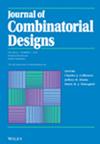二次拉丁平方的环与反完美1-因子分解
IF 0.8
4区 数学
Q3 MATHEMATICS
引用次数: 0
摘要
n$n$阶的拉丁正方形是n$n$个符号,这样每个符号在每行和每列中只出现一次。对于奇素数幂q$q$,设Fq${\mathbb{F}}_{q}$表示阶的有限域q$q$。二次拉丁方是拉丁方L[a,b]$由本文章由计算机程序翻译,如有差异,请以英文原文为准。
Cycles of quadratic Latin squares and antiperfect 1-factorisations
A Latin square of order is an matrix of symbols, such that each symbol occurs exactly once in each row and column. For an odd prime power let denote the finite field of order . A quadratic Latin square is a Latin square defined by
求助全文
通过发布文献求助,成功后即可免费获取论文全文。
去求助
来源期刊
CiteScore
1.60
自引率
14.30%
发文量
55
审稿时长
>12 weeks
期刊介绍:
The Journal of Combinatorial Designs is an international journal devoted to the timely publication of the most influential papers in the area of combinatorial design theory. All topics in design theory, and in which design theory has important applications, are covered, including:
block designs, t-designs, pairwise balanced designs and group divisible designs
Latin squares, quasigroups, and related algebras
computational methods in design theory
construction methods
applications in computer science, experimental design theory, and coding theory
graph decompositions, factorizations, and design-theoretic techniques in graph theory and extremal combinatorics
finite geometry and its relation with design theory.
algebraic aspects of design theory.
Researchers and scientists can depend on the Journal of Combinatorial Designs for the most recent developments in this rapidly growing field, and to provide a forum for both theoretical research and applications. All papers appearing in the Journal of Combinatorial Designs are carefully peer refereed.

 求助内容:
求助内容: 应助结果提醒方式:
应助结果提醒方式:


